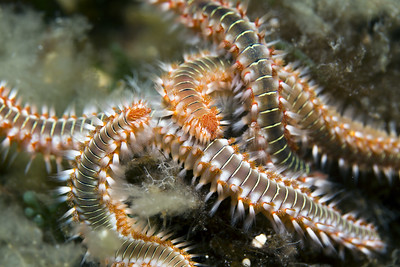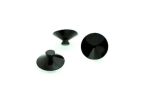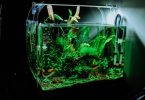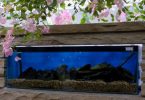Table of Contents
If you have reef tanks, then you must have probably heard of bristle worms or know a little about them. You might have even seen them but are unable to actually identify them.
Bristle worms are the worms from your aquarium, and they tend to also live in live rocks, sand of beach, along shorelines, depths of the ocean, and some other places that have the tendency of being damp.
Bristle worms are small, soft, segmented worms that belong to the phylum “Annelida” and to the class of “Polychaete”, a Greek word meaning “many bristles” or “many hairs”.
This is because they are characterized by bristly tufts sticking out of each of the segments of their body. Polychaetes include lugworms, sandworms, clamworms, rag worms, blood worms, and so many others. They are a marine species as well as nocturnals.
They come in different sizes, from tiny microscopic size to their general growth range( which is about one to eight inches long). Their colours also vary as well, they may be brightly colored, iridescent or luminescent.
Bristle worms are both scavengers and detritivores as they feed on carrion, uneaten foods, detritus which includes the bodies or parts of the bodies of dead organisms, and other fecal materials, plankton and decaying stuffs such as wastes from food, organic matters like algae, leaves to mention but a few.
In this article, I will tell you all you need to know about bristle worms, just read till the final full stop.
Identification of Bristle Worms
The polychaetes are divided into three (3) distinct parts and they include :
(a) The head
(b) The segmented trunk
(c) The terminal end
The head
They have well-developed head features such as the eyes, a pair of antennae, long and thin tentacles, sensory palps, a nuchal organ lined with chitin which aids the detection of food, the mouth which includes a pair of jaws and a pharynx.
The Eyes
Their number of eyes vary based on the species. In some species such as the ragworms and the clam worms, they possess two pairs of eyes while the green bristle worms possess between two and four pairs of eyes aiding them to distinguish only light from dark.
In addition, some species are completely blind while some possess large eyes with lenses which provide a clearer vision.
The Mouth
The mouth can be found between the prostomium and the peristomium. It is made up of extendable and retractable pairs of jaws.
The Antennas
The antennae are the sensory organs of the bristle worms and they are usually short. Most animals without backbones have antennas.
The pharynx
The pharynx plays an important role in their digestion as it aids feeding and sometimes burrowing.
Segmented trunk
Structurally, bristle worms have bodies that are divided into repeated segments. These unique segmentations aid their movement.
The segments have their own local nerve center called ganglion and a pair of nephridia(sing. nephridium) aiding excretion of wastes
Parapodia
Each of these segments possess a pair of vascularized, fleshy leg-like extensions known as parapodia(parapodium),which vary in shape depending on the species.
These appendages help them in movement (locomotion), burrowing, in their feeding processes and respiration (gas exchange) especially in large active bristle worms. They are branched at the ends.
Setae (Chaetae)
They are chitinous bristles that enclose the parapodia and they aid movement and feeding. Some of the types of setae include: Simple, compound, limbate, bifurcate, pectinate etc.
Tail (Terminal End)
This is the posterior part of the worm and it contains the anus. Cirri may also be present . The outer body part of the worm is made up of a columnar cuticular epithelium.
In addition, they possess a simple but well-developed circulatory system with two blood vessels. The digestive system is a simple tube while the nervous system is made of a single/double ventral nerve cord.
Habitats of Bristle worms
They are mainly marine and can be found inhabiting many habitats such as the depths of oceans, sand in the beach, sand in the reefs of aquariums, some tend to live in live rocks.
Some can live among the planktons, some are active swimmers floating free near aquatic surfaces in open water aquatic habitats such as surfaces and depths of oceans and a few others.
Some are burrowers burrowing the mud or sand, some are tube builders eg, tube building worms construct temporary or permanent tubes in the sediment using their mucus mixed with stone, sand and other foreign materials. The tubes may be straight, branched, U-shaped or spiraled.
Some live as commensals depending on other organisms for their shelter, food and protection while bristle worms with specialized gills or tentacles live as filter feeders.
Also, namanercidirae ( a bristle worm) live in the terrestrial environment. Some can also be found in the tank.
As scavengers, they feed on dead organic matters thus help in keeping the health of the tank in check. They will help to control algal growth by removing the wastes that would promote algal growth and development.
It can be deduced that the habitat of these worms are greatly affected and influenced by their feeding modifications and adaptations.
They play a role in marine food chains and they help recycle organic matter because of their populace in the marine habitat.
Species of Bristle worms
There are two major groups(species) and they are as follows:
- The Errant (Free-moving)species
- The Sedentary (Tube-building) species
ERRANT SPECIES
These species are the free-moving species as they use the parapodia as their locomotory organelles.
They possess segments which comprise of the trunk and a distinct head with two pair of eyes, two palps, a pair of antennae and four pair of tentacles with which they capture their foods.
They are active crawlers and swimmers so they live freely in tanks, crevices or under rocks on seashores. They are scavengers and predators thus they cause more harm than the sedentary species.
Examples of errant species include fireworms, clamworms (Alittasuccina ), sea mouse, rag worms etc
SEDENTARY SPECIES
These species of bristle worms act as burrowers burrowing the mud or sand or as tube builders living in tubes composed of mucus mixed with sand and other foreign materials. These tubes protect them from predators and aid them in catching their preys.
They possess prostomial sense organs which are reduced or lost. They cannot move around or they have very limited movement. They possess special types of appendages that help them capture food.
Examples include Christmas tree worm, lugworms (Arenicolamarina ), fan worms and other things.
How harmful bristle worms can be
Of all species of worms, the most dangerous is the bristle worms. Their harms can be considered when dividing them into two forms:
- The good bristle worms
- The bad bristle worms
The good bristle worms
It is also known as the “common” bristle worm. They are lightly(dully) coloured. They are often considered harmless.
Although, they may bite when handled ,and they can use their defensive bristles (spines or chaetae) to sting the aquarist or hobbyist when touched.
This is why it is very necessary to use heavy gloves when handling these worms.
These worms do not attack live aquatics but they are beneficial detritivores and scavengers feeding on leftover foods, leaves, wastes, already dead or almost dead organisms such as algae, fish and their wastes, shrimps, snails and a lot more. They clean up messes, prevent overfeeding, and devour the algae.
The bad bristle worms
Bad bristle worms are those referred to as Fire worms (Hermodice carunculata) and they can be quite detrimental to the aquatics.
They are free-living bristle worms (Errant form) which are larger and heavier than most of other species of bristle worms growing between 6-inches to 12-inches long.
They are more brightly colored between bright red and orange shades on their bodies than other bristle worms. They’re also more aggressive and generally more active than other species of bristle worms.
The bearded fire worm is the most detrimental of the fire worm and it is a carnivore which readily attacks the fish, corals, molluscs, anemones and crustaceans in the aquarium.
They also use their strong jaws for biting (feeding) and their venom-filled detachable bristles (chaetae) to inject their toxic secretions containing neurotoxin into their preys.
The sting can cause very intense irritation, severe pains, burning sensations which can be reduced using vinegar, alcohol, hydro-cortisone cream, strong skin inflammation or edema, pains, local necrosis, intense itching and numbness of the affected area.
Controlling Bristle Worms
Bristle worms can be controlled through certain effective ways and they are as follows:
-
Use of Natural Predators
Biologically, natural predators can be introduced into the reef or tank in order to control the bristle worms.
Examples of natural predators that can be used include spider crab or arrow crab (Stenorhynchus setrcornis), hawkfish, certain species of wrasse, such as the sixline wrasse (sixstripe wrasse), butterfly fish, dotty back, puffer fish, coral banded shrimp (Stenopus hispidus), such as red and white banded coral shrimp, golden coral shrimp and a lot more.
These natural predators not only control fire worms but also they improve the lustre of your aquarium. This method is generally a safe way to control bristle worms but adequate care should be taken when choosing them. It is very important to make sure to choose species that won’t harm the other animals in the tank.
-
Use of bristle worm traps
Bristle worm traps (either store- purchased or DO it yourself mechanism) can be used to capture fire worms especially in tanks with limited space. It is very efficient for catching smaller worms.
The trap is allowed to sink into the bottom of the tank with scallops and shrimps used as baits. The baits will attract the worms to the trap, they will get into the bottle and be trapped.
You can empty them off and replace again into the bottom of the tank. One other advantage of this method is that is relatively inexpensive.
-
Use of tweezers or tongs
It may be important to remove chunks of your live rock from the aquarium so as to make it easier to remove them.
This form of method can be very time-consuming and energy-consuming .It is only efficient if there is only a small quantity of worms in the tank.
-
Use of de-chlorinated water
This method is best used when the tank is not overpopulated. In this method, the live rock believed to be inhabiting these worms are removed and placed carefully into a fresh de-chlorinated water.
Precaution should be taken as this method is harmful to any other creature using the live rock as it’s home.
-
Prior prevention
Taking proper care to make sure the worms don’t enter the tank is the most important method of control.
Make sure that the new rocks bought are properly inspected to make sure there are no worms on them before they are used.
Other methods include:
Handpicking, use of nets, use of adhesive tapes or removal of their food source.
Economic importance of Bristle worms
-
In Fishing
Polychaete worms play a great role in the fishing industry because they help provide a healthy environment for the fish to grow.
-
Source of Food
Bristle worms are highly abundant in the marine environments, they serve as food to fish and their larva and other large vertebrates such as arrow crabs ,wrasses, trigger fish, dottybacks, gobies, coral banded shrimp, puffer fish, horseshoe crabs etc in marine benthic food chain.
They serve as food for those in some parts of the world such as South China, New Zealand, example Palolo worms. This is because of their high caloric and protein content.
Some polychaetes such as nereids, copepods also serve as a source of food to birds as well.
-
Recycling
They help in the decomposition and breakdown of the plant materials /organic sediment matter (bioturbation ) in the sea thereby aiding recycling of organic matters leading to the production of ammonia.
One vital importance of bioturbation is that it helps to keep the organic material from taking the bacteria and making use of all the oxygen. An example of a bristle worm that help in recycling is the benthos
-
Marine Environmental Quality
They serve as indicator for monitoring the health condition of the environments (especially, the marine environment) by checking for any noticeable changes in the environment.
Biiomakers present in polychaetes can be used to indicate contamination caused by heavy metals or pesticide.
-
Source of Pesticides and Insecticides
They are used to produce pesticides and insecticides used against pests.
-
Recreational Fishing
Other species are dug out and used by fishermen as baits for fishing.
-
Effect on Aquatics
Some of them harm corals, fish, crustaceans, molluscs etc. Some also affect the appearance of the oysters and hence reduce their market value, example is the Fire worms.
-
Removal of wastes
Bristle worms help to keep the tank healthy by preventing the algae from building up. It also feeds on unwanted food, leaves, decayed matters, and fish wastes. Example I’d the sedentary worms.
Facts about Bristle worms
- Bristle worms are related to leeches and earthworms. They all belong to the phylum Annelida.
- Polychaete is a word coined from two Greek words -poly meaning many and chaeta meaning bristle.
- The polychaete is the highest annelid class with over 10,000 species as well as the most primitive of the annelid classes.
- Bristle worms can be scavengers feeding on carrions and algae. They can be detritivores feeding on dead organic matters and wastes. They can be carnivores especially fire worms feeding on fish.
- They are most commonly found at the sand beaches, intertidal zones, islands, sediments, waste, ocean (most depths), reefs etc.
- Typically, all annelids excrete using the metanephridia and protonephridia and typically a pair can strategically be found in each segment. It is well-developed bristle worms dwelling in the terrestrial and the freshwater habitats.
- Bristle worms are nocturnal organisms. They can only be seen in the daylight when they are disturbed .
- Most polychaetes are small in size , except the bobbit worm (Eunice aphroditois) which is ten feet in length.
- Bristle worms should not be touched with bare hands as they can break apart easily when handled and they can redevelop their lost parts. When you want to go to the tank, make sure to wear your shoes and your hand gloves.
- Their reproductive organs are developed only during the breeding season and then fade away soon afterwards
- Their sexes are separate unlike the leeches and the earthworms that are hermaphroditic.
- The gametes are shed into the water. In other words, they reproduce their eggs and sperm into the water.
- Some bristle worms can also reproduce by means of epitoky.
- Their tentacles are lined with cilia called “nuchal organs” which are chemoreceptors (chemosensors).
- Their appendages called parapodia serve as organ for gas exchange (respiration) and locomotion.
- They possess strong jaws which are formed from sclerotised collagen and chatae(setae) formed from sclerotised chitin.
Conclusion
In conclusion, when you’re an aquarist or a hobbyist ,it’s very important for you to remember the two basic types of bristle worm you are going to encounter.
(The good bristle worms and the bad bristle worms) and the best way to handle and control them so that you don’t expose your tank and it’s inhabitants to great risk.







